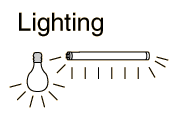Fluorescent Lighting
 |
Although there are a large number of lighting options, the majority of lighting in homes is done by either incandescent or fluorescent lights. Fluorescent lighting has a considerable advantage in energy efficiency over incandescent lighting. Fluorescent lights can produce 50-100 lumens/watt compared to about 15 lumens/watt for incandescent bulbs. |
The familiar geometry of fluorescent lights involve a long narrow glass tube with two electrical connections on each of the metal caps which seal the ends of the tube. The tube is filled with noble gases such as argon, neon or krypton to suppress chemical reactions resulting from the electrical discharges in the tube. According to Bloomfield, these gases are at a pressure of about 0.3% of atmospheric pressure. A few drops of mercury is placed in the tube, and the vapor pressure is sufficient so that something like one in a thousand of the atoms inside the tube is a mercury atom in the gas phase. The properties of these mercury atoms make them very efficient light emitters by fluorescence when they are struck by energetic electrons inside the tube.
If electrons are removed from the mercury atoms by collisions with high speed electrons, they can produce light by emission (see mercury spectrum) when electrons make transitions downward to fill the electron gaps produced. One key to getting light out of the fluorescent tube is then to produce the high speed electrons which can "excite" the mercury atoms so that they will produce light. This is done in most fluorescent tubes by heating a filament in the end of the tube, which frees some electrons . Other types use high voltages to eject electrons from electrodes at the ends. Once freed, the electrons can be accelerated in the tube by the applied AC voltage. Some of the electrons transfer energy to the mercury atoms in collisions, so that one or more of the electrons of the mercury atom is elevated to an excited state. Once the electrical discharge in the tube is started, the current must be controlled to maintain a steady light source. This is done by coil arrangement called a fluorescent light ballast.
The process of producing light from the mercury atoms is fairly efficient, but a large part of it is in the ultraviolet rather than the visible range. The final transition of the electrons to the ground state of the mercury atom produces light at 254 nm, considerably below the blue limit of human vision at about 400 nm. The ultraviolet light does not get through the glass envelope of the tube, but because of its high quantum energy it can be used to advantage in producing visible light. To produce light in the visible range, the inside of the tube is coated with a phosphor powder. When the ultraviolet light strikes the powder, it produces excitations of the electrons of the phosphor which then produce visible light by a process called fluorescence. Ultraviolet photons associated with the 254 nm uv light have quantum energies of 4.9 electron volts, whereas the energy range for the visible photons which we can see is from 1.6 to 3.1 eV. Since there are many intermediate levels for the electrons to drop to after being excited by the uv photons, they can produce visible photons of light throughout the visible range, producing nearly white light.
The production of white light is a challenging undertaking. In the case of the fluorescent lights, a carefully selected and blended set of phosphors is used so that the wavelengths at which it fluoresces are distributed evenly over the visible range. Current fluorescent lighting uses six standard phosphor blends: cool white, deluxe cool white, warm white, deluxe warm white, white, and daylight. The daylight phosphor which was used in early fluorescent lights tips the light toward the blue end and is criticized as being "cold". The "cool" phosphors resemble daylight and are more nearly color neutral, while the "warm" phospors tip the spectrum toward the red end and resemble incandescent lighting.
| Comment on energy cost | Energy units |
| Household energy use |
Practical electric circuits
Reference
Bloomfield
Ch 12
| HyperPhysics***** Electricity and Magnetism | R Nave |